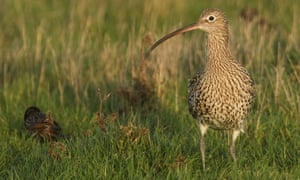Commercial tree plantations in Britain do not store carbon to help the climate crisis because more than half of the harvested timber is used for less than 15 years and a quarter is burned, according to a new report.
While fast-growing non-native conifers can sequester carbon more quickly than slow-growing broadleaved trees, that carbon is released again if the trees are harvested and the wood is burned or used in products with short lifespans, such as packaging, pallets and fencing.
Of the UK’s 2018 timber harvest, 23% was used for wood fuel, while 56% was taken to sawmills. Only 33% of the wood used by sawmills was for construction, where wood used in permanent buildings can lock in carbon for decades. Much of sawmill wood was used for fencing (36%) with a service life of 15 years, or packaging and pallets (24%) or paper (4%).
“There is no point growing a lot of fast-growing conifers with the logic that they sequester carbon quickly if they then go into a paper mill because all that carbon will be lost to the atmosphere within a few years,” said Thomas Lancaster, head of UK land policy at the Royal Society for the Protection of Birds (RSPB), which commissioned the report. “We should not be justifying non-native forestry on carbon grounds if it’s not being used as a long-term carbon store.”

The Committee on Climate Change has called for 1.5 billion new trees by 2050 – requiring planting on 30,000 hectares (74,000 acres) of land a year, increasing Britain’s forest cover from 13% to 19%.
Many of these new forests will also provide a commercial timber crop. But the scientific review by the ecologist Ellie Crane of how forestry can best address the climate and biodiversity crisis finds that there is no simple solution in Britain.
The best place for non-native conifers to quickly sequester carbon is on intensively farmed lowland but this high-quality agricultural land is too expensive for forestry to make financial sense for landowners.
Planting conifers on the cheapest land such as the blanket bogs of Scotland’s Flow Country is “disastrous” for biodiversity, according to Lancaster, but also leads to carbon emissions because the bogs are drained for forestry and the peat degrades, releasing carbon into the atmosphere.
This leaves “shallow peat” moorlands of western Scotland, south and mid-Wales and parts of the Lake District and the Pennines as the most likely locations for new carbon-sequestering forests. Here, the RSPB has concerns about the impact on wildlife. Rare and declining species such as the curlew that breed on open moorland cannot survive close to plantations, which become home to predators of their chicks such as crows.
While the best option for wildlife and slower but long-term carbon sequestration is to plant broadleaved woodlands in the right locations and leave them intact, if Britain does not produce its own timber it will import more – in effect exporting its carbon footprint overseas.
“It’s clearly not just a question of more trees equals a safer climate. Trees in the wrong place could exacerbate climate change and biodiversity decline,” said Lancaster. “There’s also a big question around the capacity of Natural England and regulatory bodies in Scotland and Wales and the forestry commissions to properly assess what impact any planting schemes will have on nature, both good and bad, and on the climate.
“If we’re serious about tackling the climate and ecological emergency there needs to be a huge government investment in capacity to get that right, otherwise we’re going to have lots of inappropriate planting which could be negative for the climate as well as biodiversity.”